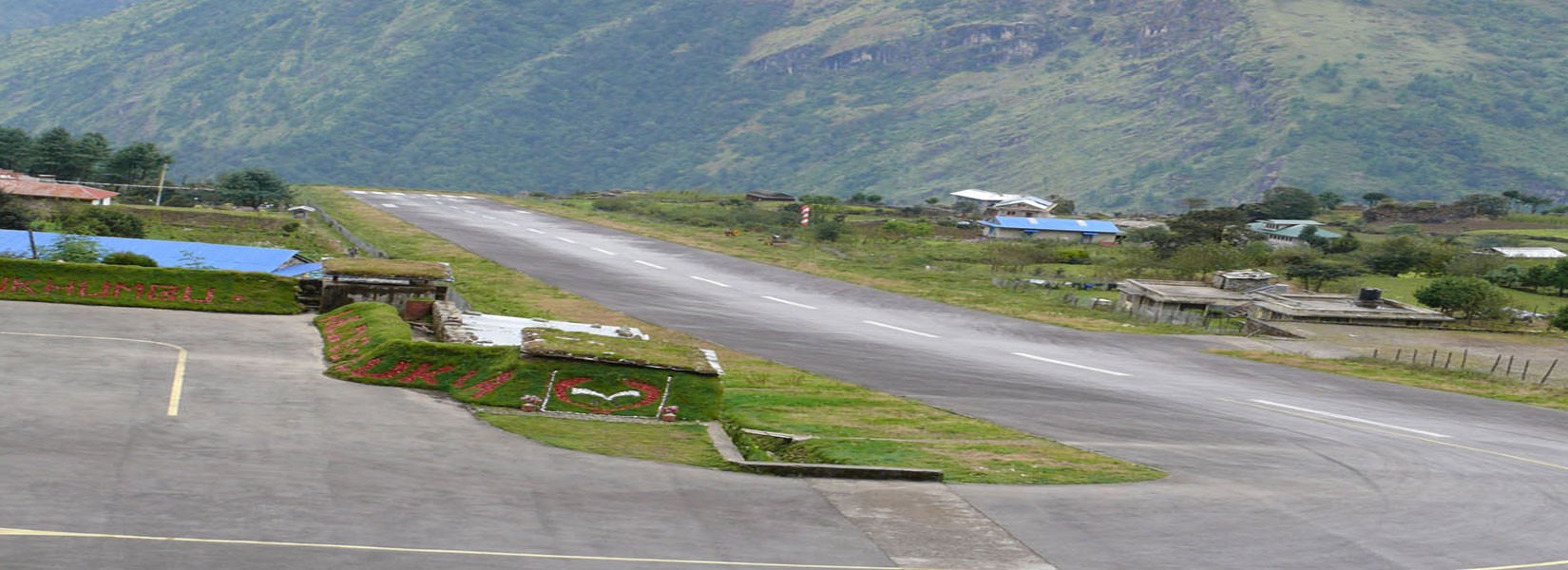Lukla Airport Everest Base Camp Trek Starts (Tenzing-Hillary Airport)
Lukla Airport IATA also known as Tenzing-Hillary Airport is a domestic airport mini-town of Lukla in Khumbu Pasanglhamu, Solukhumbu Distric, Koshi Province of Nepal. The Airport is popular because this is the main gateway for the Everest Base Camp Trek, expeditions, peak climbing, and other activities. It is one of the most Extreme Airport and adventurous flying from Kathmandu. Approximately 35-40 minutes flight can be clear.
The Airport is situated at 2840m/9317ft. There are daily flights between Lukla and Kathmandu during daylight hours in good weather conditions. The flight distance is short, rain commonly occurs in Lukla while the sun is shining brightly in Kathmandu. High winds, cloud cover, and changing visibility often mean flights can be delayed or the airport is closed. The airport is contained within a chain-link fence and is patrolled by the Nepali armed police of civil police around the clock for security.
In the main trekking season: April/May and October/November flights will operate to Lukla flight through Manthali-Ramechhap, from there flight journey is short and reliable but every travel requires leaving from Kathmandu early in the morning to catch the flight to Lukla and the overland journey is quite long between 4-5 hours.
Airport History
The airport was built in 1964 under the supervision of Sir Edmund Hillary, who originally intended to build it on flat farmland. Conversely, local farmers did not want to give up their land, so the airport was built in its current position. Hillary bought the land from a local Sherpa owner for USD 2,650 and involved them in building the facilities but Hillary was unhappy with the runway’s soil resistance, and that solution was to buy local liquor for the Sherpas and ask them to perform a foot-stomping dance to flatten the land that served as the runway. The runway was not paved until 2001.
In January 2028, the airport was renamed in honor of Sherpa Tenzing Norgay and Sir Edmund Hillary, the first people confirmed to have reached the summit of Mount Everest and trekking-peak climbing and also to mark their efforts in the construction of the airport.
Facilities
Landing and taking off at Lukla Tenzing-Hillary Airport. A plane landing in the airport before paving off the runway. The airport’s paved asphalt runway is accessible only to helicopters and small, fixed-wing short-takeoff and landing aircraft such as the De Havilland Canada DHC-6 Twin Otter, Dornier 228 x 30 m (98 ft.) with an 11. 7% gradient. The airport’s elevation is 9,317 ft. (2,840 m) the airport is used for passenger flights and for transporting most of the building materials and cargo to Lukla and other towns and villages to the north of Lukla as there is no road to this region.
In the early morning, the wind is usually from the northeast, changing to a southwest wind from early to late morning due to the action of the sun on the mountains to the north of Lukla. The airport regularly closes from mid to late morning due to the strong southwest winds that create crosswinds and/or tailwinds. That is why, flights are usually scheduled for the early morning between Kathmandu and Lukla. A sudden loss of visibility prevents planes from landing under visual flight rules (VFR) and will result in the immediate closure of the airport with no warning. Although the airport is nominally open throughout the year, visibility problems close the airport 50% of the time during the monsoon season, with the consequent cancellation of % of flights. Due to the terrain and the low possibility of a safe go-around for a missed approach, there are no go-around procedures for the airport.
Tenzing-Hillary Airport is frequently referred to as the most dangerous airport in the world. Arriving and departing aircraft must use a single runway (06 for landing and 24 for takeoff). There is high terrain immediately beyond the northern end of the runway and a steeply angled drop at the southern end of the runway into the valley.
Due to the difficulties of successfully landing at the airport, the Civil Aviation Authority of Nepal sets high standards, according to which only experienced pilots, who have completed at least 100 short-takeoff and landing (STOL) missions, have over one year of STOL experience in Nepal, and have completed ten flight into Lukla with certified instructor pilot, are allowed to land at the airport.

